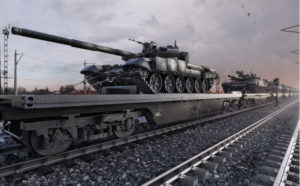According to Emily Ferris, in Foreign Policy, Russia’s military logistics capability is overreliant on its railroads, and the country has faced difficulties in Ukraine because of that. She writes:
Russia has scaled down its war goals in Ukraine, redeploying its forces to focus on the eastern Donbas region and the strategic port city of Odesa. A central question now is whether this shift in strategy will help solve the Russian military’s many problems with wartime logistics.
Many of these challenges have been well documented, including issues in refueling and resupplying its troops as well as transporting injured soldiers back to neighboring Belarus to receive medical attention. But refocusing on a smaller area may allow Russia to alleviate an underlying logistical problem: Russia’s overwhelming dependence on railways—and on trucks beyond the end of those tracks—to move its troops and military equipment.
Roads and railways have for decades been the backbone of Russia’s military as well as its commercial supplies. A vast territory, Russia is sparsely and unevenly populated, with most people concentrated in the European part of Russia. Its expansive geography and difficult terrain—featuring steppe, permafrost, and seasonal flooding—mean that the standing army of motorized ground forces relies on its rail and road networks to transport troops, food, and fuel in war and peacetime.
Unlike any other standing army, Russia has an auxiliary service known as the Railway Troops (or “zheleznodorozhniye voiska”), which protect and maintain the railway services for use during combat. Their 10 brigades are attached to military districts and work to repair damaged lines, build or reconstruct bridges, and assist the armed forces in concealment. They can also supply fuel, clothing, and weapons to the front as well as restore road and rail access if they are bombed in combat.
These engineering troops played an important role in Chechnya in the late 1990s, reconstructing transport infrastructure and restoring communication lines as well as constructing parts of the Baikal-Amur Mainline railway in Russia’s Far East, which is dually used to transport civilians and military personnel across difficult terrain. As Russia rotates its troops and resupplies the front in the eastern Donbas with battalions from far-flung places, such as Vladivostok and Kamchatka in the Far East, it will be more reliant than ever on these railway lines to transport troops to the front.
But overreliance on the railways for large-scale troop deployment seems to have been one of Russia’s main stumbling blocks in this war. Railways link up large urban areas and industrial facilities, but the army’s failure to capture important logistical hubs in Ukraine, such as the city of Kharkiv, means they cannot commandeer local railway infrastructure to transport their infrastructure and soldiers farther into Ukraine and capture more territory. Even in the south where the Russian armed forces made some gains, they do not fully control the railways near Melitopol, where Russian armored trains were deployed from Crimea in early March. They have, however, managed to take control of some small industrial facilities in Kherson and have opened up the rail connection between Kherson and annexed Crimea, which may ameliorate some of their logistical issues in the south.
If you’re willing to fight for Main Street America, click here to sign up for the Richardcyoung.com free weekly email.





